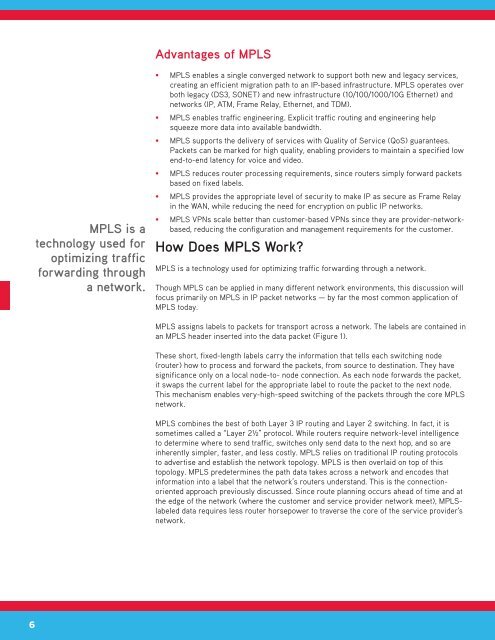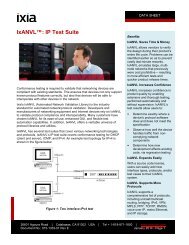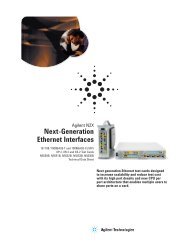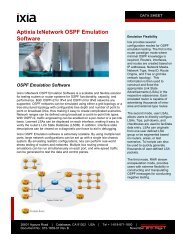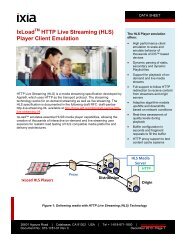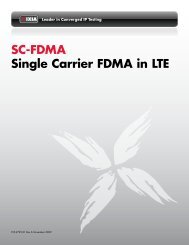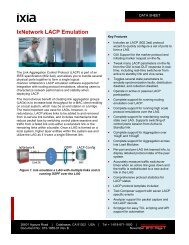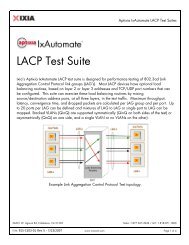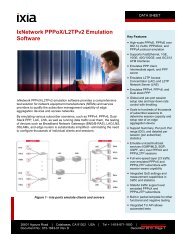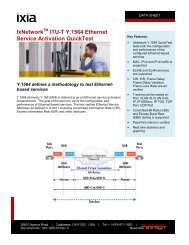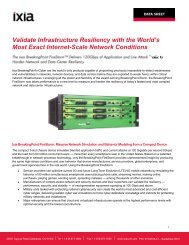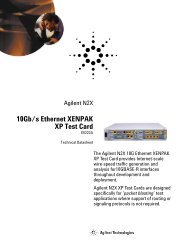Multi-Protocol Label Switching (MPLS) Conformance and ... - Ixia
Multi-Protocol Label Switching (MPLS) Conformance and ... - Ixia
Multi-Protocol Label Switching (MPLS) Conformance and ... - Ixia
Create successful ePaper yourself
Turn your PDF publications into a flip-book with our unique Google optimized e-Paper software.
Advantages of <strong>MPLS</strong><strong>MPLS</strong> is atechnology used foroptimizing trafficforwarding througha network.• <strong>MPLS</strong> enables a single converged network to support both new <strong>and</strong> legacy services,creating an efficient migration path to an IP-based infrastructure. <strong>MPLS</strong> operates overboth legacy (DS3, SONET) <strong>and</strong> new infrastructure (10/100/1000/10G Ethernet) <strong>and</strong>networks (IP, ATM, Frame Relay, Ethernet, <strong>and</strong> TDM).• <strong>MPLS</strong> enables traffic engineering. Explicit traffic routing <strong>and</strong> engineering helpsqueeze more data into available b<strong>and</strong>width.• <strong>MPLS</strong> supports the delivery of services with Quality of Service (QoS) guarantees.Packets can be marked for high quality, enabling providers to maintain a specified lowend-to-end latency for voice <strong>and</strong> video.• <strong>MPLS</strong> reduces router processing requirements, since routers simply forward packetsbased on fixed labels.• <strong>MPLS</strong> provides the appropriate level of security to make IP as secure as Frame Relayin the WAN, while reducing the need for encryption on public IP networks.• <strong>MPLS</strong> VPNs scale better than customer-based VPNs since they are provider-networkbased,reducing the configuration <strong>and</strong> management requirements for the customer.How Does <strong>MPLS</strong> Work?<strong>MPLS</strong> is a technology used for optimizing traffic forwarding through a network.Though <strong>MPLS</strong> can be applied in many different network environments, this discussion willfocus primarily on <strong>MPLS</strong> in IP packet networks — by far the most common application of<strong>MPLS</strong> today.<strong>MPLS</strong> assigns labels to packets for transport across a network. The labels are contained inan <strong>MPLS</strong> header inserted into the data packet (Figure 1).These short, fixed-length labels carry the information that tells each switching node(router) how to process <strong>and</strong> forward the packets, from source to destination. They havesignificance only on a local node-to- node connection. As each node forwards the packet,it swaps the current label for the appropriate label to route the packet to the next node.This mechanism enables very-high-speed switching of the packets through the core <strong>MPLS</strong>network.<strong>MPLS</strong> combines the best of both Layer 3 IP routing <strong>and</strong> Layer 2 switching. In fact, it issometimes called a “Layer 2½” protocol. While routers require network-level intelligenceto determine where to send traffic, switches only send data to the next hop, <strong>and</strong> so areinherently simpler, faster, <strong>and</strong> less costly. <strong>MPLS</strong> relies on traditional IP routing protocolsto advertise <strong>and</strong> establish the network topology. <strong>MPLS</strong> is then overlaid on top of thistopology. <strong>MPLS</strong> predetermines the path data takes across a network <strong>and</strong> encodes thatinformation into a label that the network’s routers underst<strong>and</strong>. This is the connectionorientedapproach previously discussed. Since route planning occurs ahead of time <strong>and</strong> atthe edge of the network (where the customer <strong>and</strong> service provider network meet), <strong>MPLS</strong>labeleddata requires less router horsepower to traverse the core of the service provider'snetwork.6


